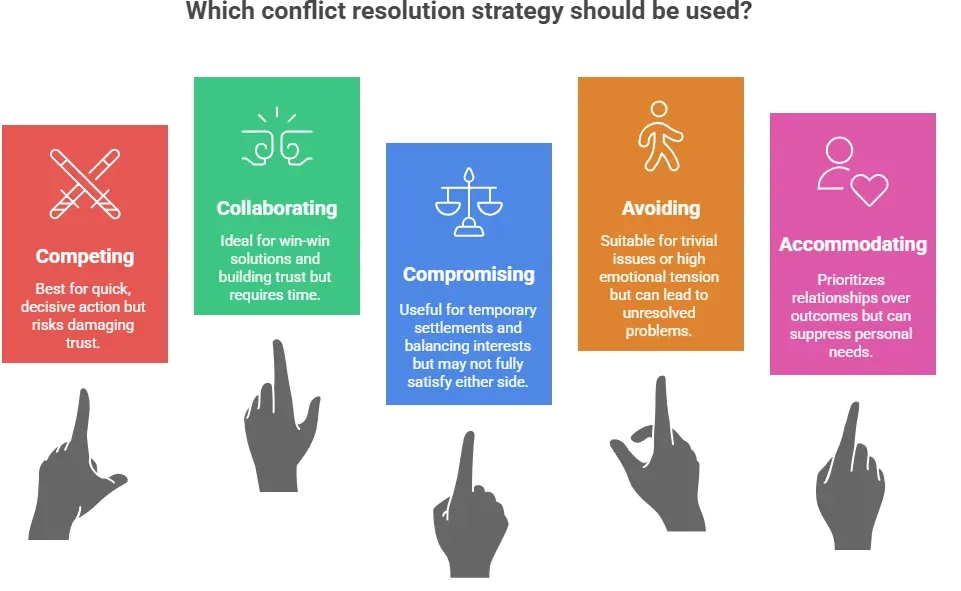What is Conflict Management? How does it build a culture of collaboration?

In today’s diverse and global workplace, conflict is unavoidable and how leaders manage it can make or break team dynamics. Differences in culture, communication styles, and values often lead to misunderstandings. Even with the best intentions, high-stakes situations and strong emotions can escalate tensions. Conflict impacts senior leaders, it drains focus, lowers morale, and disrupts productivity.
Workplace conflict is both inevitable and increasingly common but when managed well, it’s not just natural, it’s essential for a healthy, high-performing organization.
To turn conflict into an opportunity rather than a setback, effective leaders must be self-aware, culturally sensitive, and skilled at navigating these challenges to foster a healthy, collaborative work environment.
What is Conflict Management?
Conflict management is the process of identifying and handling disputes in a constructive way. It involves communication, negotiation, and problem-solving skills to resolve disagreements, reduce tension, and promote collaboration, ensuring that conflicts do not escalate and relationships remain productive and respectful.
Core Conflict Management Techniques
While there are several approaches to conflict, some can be more effective than others.
One of the most widely used models for understanding how people approach conflict is the Thomas-Kilmann Conflict Mode Instrument (TKI), developed by Ken Thomas and Ralph Kilmann.
The TKI framework outlines five distinct conflict-handling styles, each reflecting different levels of assertiveness and cooperativeness in how individuals respond to disagreements.

1. Competing (Win-Lose)
Competing means pursuing your own concerns at the other party’s expense being assertive and uncooperative. Use this when quick, decisive action is needed (e.g. emergencies, discipline, protecting rights). While sometimes necessary, especially in high‐stakes situations, it risks damaging trust, alienating others, and creating resistance if used frequently
2. Collaborating (Win-Win)
Collaboration aims for a win‐win solution, both parties work together to fully satisfy each other’s goals and preserve the relationship. This strategy is best when both the issue and the relationship are important. It takes time, creativity, and open communication. When done well, it builds trust, innovation, and long‐term cooperation.
3. Compromising (Lose-Lose or Partial Win-Win)
Compromising means finding a middle ground: both sides give up something and gain something. It’s useful when the goals are moderately important, time is limited, or when temporary settlements are acceptable. It balances assertiveness and cooperativeness, though it may result in only partially satisfying each side’s interests.
4. Avoiding (Lose-Lose)
This strategy involves withdrawing from, postponing, or sidestepping conflict. It is best used when the issue is trivial, the cost of confrontation is higher than the benefit, or when emotions are too charged to resolve the conflict constructively. Overuse in critical situations, however, can lead to unresolved issues, misunderstandings, and deteriorating relationships.
5. Accommodating (Lose-Win)
In accommodating, you yield to another’s needs and goals above your own. This approach prioritizes the relationship over the outcome. It works when harmony matters more than being right, or when one side recognizes they have less at stake. But accommodating too often can suppress one’s own needs and lead to resentment.
Why Conflict is Not Always a Bad Thing!
Conflict is often seen negatively, but when managed well, it can drive growth and innovation. It pushes teams to think differently, challenge assumptions, and find creative solutions. Diverse perspectives can lead to richer discussions and better decisions by avoiding groupthink. Handling conflict also builds emotional intelligence, empathy, and active listening skills that strengthen relationships and foster a more collaborative workplace culture.
The Link Between Conflict Management and Collaboration
Drives Growth Through Constructive Handling: Conflict, when managed well, becomes a driver of growth rather than a barrier. It encourages learning, innovation, and continuous improvement within teams.
Encourages Open Communication: Healthy conflict resolution creates space for team members to:
- Voice concerns
- Share ideas
- Challenge assumptions
This openness builds trust, making individuals feel heard and valued.
Builds Trust and Psychological Safety: When people know disagreements will be handled fairly and respectfully:
- They engage more fully
- They contribute more creatively
Psychological safety is a key trait of high-performing teams.
Promotes Mutual Respect: Conflict management reinforces respect among team members, helping maintain a positive and inclusive team culture.
Proven Success in Leading Organizations: Companies like Google and IDEO show that teams with strong conflict resolution practices:
- Navigate tension effectively
- Maintain cohesion
- Consistently outperform others
Transforms Disruption into Opportunity: By treating conflict as a natural part of teamwork, leaders can turn potential disruptions into:
- Deeper understanding
- Stronger collaboration
Strategies to Build a Culture of Collaboration Through Conflict Management
1. Establish Clear Communication Norms
Creating a collaborative culture starts with setting expectations for how team members communicate. Clear norms help reduce misunderstandings that often lead to conflict. This includes guidelines for tone, responsiveness, channels of communication, and how to respectfully disagree. When everyone knows how to communicate effectively, conflicts can be addressed early and constructively.
2. Foster Understanding Through Listening, Empathy, and Respect
Conflict worsens when people feel unheard or misunderstood. Active listening and empathy help people understand each other’s perspectives, reducing defensiveness and enabling more collaborative problem-solving.
Respect matters: when team members feel valued, honest dialogue is possible even in disagreement. Leaders can show respect by listening without interrupting and acknowledging concerns, even when they disagree. That builds trust and improves chances of finding solutions that work for everyone.
3. Train Managers and Teams in Conflict Resolution Skills
Managers and teams need practical tools to navigate conflict. This includes training in negotiation, emotional intelligence, mediation, and de-escalation techniques. When employees are equipped with conflict resolution skills, they are more likely to approach conflicts as opportunities for growth rather than threats, strengthening collaboration across the organization.
4. Encourage Feedback and Open Dialogue
A feedback-rich environment encourages transparency and trust. When feedback is normalized and shared constructively, issues are less likely to fester into major conflicts. Open dialogue invites diverse viewpoints and fosters psychological safety, which are essential for both innovation and healthy conflict resolution.
5. Lead by Example: Conflict-Competent Leadership
Leaders set the tone for how conflict is handled within an organization. When leaders model calm, respectful, and solution-oriented responses to conflict, it signals to others that disagreement can be healthy and productive. Conflict-competent leadership cultivates a culture where collaboration thrives even when perspectives clash.
Common Workplace Conflict Examples and How to Resolve Them
Conflicts at work can stem from a range of causes personality clashes, miscommunication, unmet expectations, or even systemic issues. Understanding these common conflict types and how to address them helps foster a healthier, more collaborative workplace.

1. Work Style Differences
Scenario: Two team members clash over how to approach tasks one prefers structured planning and deadlines, while the other thrives in last-minute creative bursts. The mismatch causes delays and frustration.
Resolution: A manager facilitates a resolution session, encouraging both parties to express their preferences. They agree on a hybrid workflow that includes planning stages and room for flexibility, ensuring both styles are accommodated without compromising project timelines.
2. Communication Breakdowns
Scenario: A younger employee’s casual email style is misunderstood by an older colleague as unprofessional. The misinterpretation leads to tension and an emotionally charged confrontation.
Resolution: The manager organizes a communication workshop focused on generational and cultural differences. Through dialogue, both employees gain awareness and agree on clear communication norms, improving mutual understanding.
3. Harassment, Discrimination, or Bullying
Scenario: An employee, Jane, reports being excluded and mocked by coworkers due to her religious beliefs. She feels harassed, isolated, and emotionally distressed.
Resolution: The issue is escalated to HR, who conducts a thorough investigation. The company reinforces anti-harassment policies, provides mandatory training, and offers Jane emotional support. Culture audits are introduced to prevent future incidents.
4. Power Struggles
Scenario: Mike, a long-time employee, is resentful after a junior colleague, Sarah, is promoted. He begins undermining her authority and challenging her in public, creating a toxic atmosphere.
Resolution: The manager clarifies roles and responsibilities in a team meeting and initiates a mentorship program, positioning Mike as a valued senior contributor while supporting Sarah’s leadership. Conflict resolution training follows to promote long-term collaboration.
5. Resistance to Change
Scenario: An office relocation causes frustration among employees due to longer commutes and unfamiliar surroundings, even though the new space offers better amenities.
Resolution: Management holds Q&A sessions, listens to concerns, and involves employees in designing the new space. Transportation options like carpools are explored to reduce inconvenience. Clear communication about the benefits helps ease resistance.
6. Poor Work Habits
Scenario: Alex consistently shows up late, misses deadlines, and is disengaged at work. His poor habits frustrate teammates who feel they are picking up his slack.
Resolution: The manager sets performance goals and timelines in a private meeting. When Alex fails to improve, they explore reassignment. If no better-fit role is found, termination becomes necessary to preserve team morale.
7. Over-Competition
Scenario: A sales contest sparks unhealthy rivalry between two employees, resulting in accusations and division within the team.
Resolution: The contest is paused, and team-building activities are introduced. Later, more inclusive and fun competitions are implemented to boost morale without fostering hostility.
8. Personality Clashes
Scenario: Tom is outspoken and dominates conversations; Sarah is quiet and prefers written communication. Their clashing styles create friction and reduce team cohesion.
Resolution: A manager arranges mediation, introduces equal speaking time during meetings, and leverages shared digital tools to accommodate different communication styles. Respect and understanding gradually improve.
9. Underperformance Due to Misaligned Expectations
Scenario: Carlos misses deadlines and delivers incomplete work. His teammates are frustrated but unaware that Carlos doesn’t fully understand recent workflow changes.
Resolution: One-on-one meetings reveal the gap. The manager clarifies expectations, offers training, and schedules weekly check-ins. This restores confidence and collaboration across the team.
10. Creative Differences
Scenario: Mia and Jordan, two designers, disagree on the product’s direction—Mia wants bold innovation; Jordan prefers data-backed safety. Their disagreement stalls progress and fuels tension.
Resolution: A facilitated session helps both express their ideas. The team blends both approaches, reaching a compromise. More importantly, it improves communication and creative collaboration moving forward.
Conclusion
Conflict is inevitable but when managed well, it becomes a powerful catalyst for collaboration, innovation, and growth. Conflict management isn’t just about resolving disputes; it’s about creating an environment where diverse perspectives fuel better decisions and stronger teams. By mastering these skills, leaders and professionals can transform tension into trust. Pursuing a business management course equips you with the frameworks, tools, and real-world insights needed to navigate these complexities with confidence empowering you to build a truly collaborative workplace culture.

TalentSprint
TalentSprint is a leading deep-tech education company. It partners with esteemed academic institutions and global corporations to offer advanced learning programs in deep-tech, management, and emerging technologies. Known for its high-impact programs co-created with think tanks and experts, TalentSprint blends academic expertise with practical industry experience.



